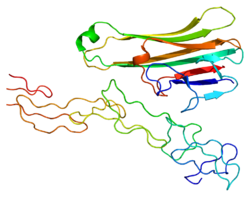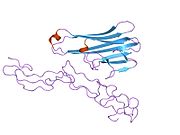Limfotoksin alfa
Prijeđi na navigaciju
Prijeđi na pretragu
| edit |
| Limfotoksin alfa (TNF superfamilija, član 1) | |||||||||||
|---|---|---|---|---|---|---|---|---|---|---|---|
 PDB prikaz baziran na 1tnr. | |||||||||||
| Dostupne strukture | |||||||||||
| 1tnr | |||||||||||
| Identifikatori | |||||||||||
| Simboli | LTA; LT; TNFB; TNFSF1 | ||||||||||
| Vanjski ID | OMIM: 153440 MGI: 104797 HomoloGene: 497 GeneCards: LTA Gene | ||||||||||
| |||||||||||
| Pregled RNK izražavanja | |||||||||||
 | |||||||||||
 | |||||||||||
| podaci | |||||||||||
| Ortolozi | |||||||||||
| Vrsta | Čovek | Miš | |||||||||
| Entrez | 4049 | 16992 | |||||||||
| Ensembl | ENSG00000204496 | ENSMUSG00000024402 | |||||||||
| UniProt | P01374 | Q542S2 | |||||||||
| RefSeq (mRNA) | NM_000595 | NM_010735 | |||||||||
| RefSeq (protein) | NP_000586 | NP_034865 | |||||||||
| Lokacija (UCSC) | Chr 6: 31.65 - 31.65 Mb | Chr 17: 34.81 - 34.81 Mb | |||||||||
| PubMed pretraga | [1] | [2] | |||||||||
Limfotoksin-alfa je protein koji je kod ljudi kodiran LTA genom.[1][2]
Limfotoksin alfa, član familije faktora nekroze tumora, je citokin koga proizvode limfociti. LTA je visoko induktivan i izlučiv. On postoji kao homotrimerni molekul. LTA formira heterotrimere sa limfotoksinom-beta, čime se limfotoksin-alfa učvršćuje za ćelijsku površinu. LTA posreduje širok niz inflamatornih, imunostimulatornih, i antiviralnih odgovora. LTA takođe učestvuje u formaciji sekundarnih limfoidnih organa tokom razvoja, i ima ulogu u apoptozi.[3]
Interakcije[uredi | uredi kod]
Za limfotoksin alfa je bilo pokazano da interaguje sa LTB.[4][5][6]
Reference[uredi | uredi kod]
- ↑ Nedwin GE, Naylor SL, Sakaguchi AY, Smith D, Jarrett-Nedwin J, Pennica D, Goeddel DV, Gray PW (Nov 1985). „Human lymphotoxin and tumor necrosis factor genes: structure, homology and chromosomal localization”. Nucleic Acids Res 13 (17): 6361–73. DOI:10.1093/nar/13.17.6361. PMC 321958. PMID 2995927.
- ↑ Aggarwal BB, Eessalu TE, Hass PE (Feb 1986). „Characterization of receptors for human tumour necrosis factor and their regulation by gamma-interferon”. Nature 318 (6047): 665–7. PMID 3001529.
- ↑ „Entrez Gene: LTA lymphotoxin alpha (TNF superfamily, member 1)”.
- ↑ Williams-Abbott, L; Walter B N, Cheung T C, Goh C R, Porter A G, Ware C F (August 1997). „The lymphotoxin-alpha (LTalpha) subunit is essential for the assembly, but not for the receptor specificity, of the membrane-anchored LTalpha1beta2 heterotrimeric ligand”. J. Biol. Chem. (UNITED STATES) 272 (31): 19451–6. DOI:10.1074/jbc.272.31.19451. ISSN 0021-9258. PMID 9235946.
- ↑ Browning, J L; Sizing I D, Lawton P, Bourdon P R, Rennert P D, Majeau G R, Ambrose C M, Hession C, Miatkowski K, Griffiths D A, Ngam-ek A, Meier W, Benjamin C D, Hochman P S (October 1997). „Characterization of lymphotoxin-alpha beta complexes on the surface of mouse lymphocytes”. J. Immunol. (UNITED STATES) 159 (7): 3288–98. ISSN 0022-1767. PMID 9317127.
- ↑ Browning, J L; Dougas I, Ngam-ek A, Bourdon P R, Ehrenfels B N, Miatkowski K, Zafari M, Yampaglia A M, Lawton P, Meier W (January 1995). „Characterization of surface lymphotoxin forms. Use of specific monoclonal antibodies and soluble receptors”. J. Immunol. (UNITED STATES) 154 (1): 33–46. ISSN 0022-1767. PMID 7995952.
Literatura[uredi | uredi kod]
- Körner H, Sedgwick JD (1997). „Tumour necrosis factor and lymphotoxin: molecular aspects and role in tissue-specific autoimmunity.”. Immunol. Cell Biol. 74 (5): 465–72. DOI:10.1038/icb.1996.77. PMID 8912010.
- Wang Q (2005). „Molecular genetics of coronary artery disease.”. Curr. Opin. Cardiol. 20 (3): 182–8. DOI:10.1097/01.hco.0000160373.77190.f1. PMC 1579824. PMID 15861005.
- Copeland KF (2006). „Modulation of HIV-1 transcription by cytokines and chemokines.”. Mini reviews in medicinal chemistry 5 (12): 1093–101. DOI:10.2174/138955705774933383. PMID 16375755.
- Elewaut D, Ware CF (2007). „The unconventional role of LT alpha beta in T cell differentiation.”. Trends Immunol. 28 (4): 169–75. DOI:10.1016/j.it.2007.02.005. PMID 17336158.
